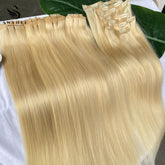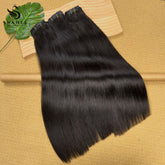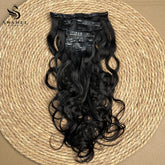How to Choose Pre-Bonded Hair? U-Tip, I-Tip, or Flat-Tip?
What are the differences between I-Tip, U-Tip, and Flat-Tip hair extensions? And how do you choose the right one for you?
Pre-bonded hair extensions, also known as keratin hair extensions, pre-bonded tip hair extensions, or (hot/cold) fusion hair extensions, have the longest history among all hair extension types and remain the top choice for many people. They are applied by heating the keratin tip at the end of the extension to bond it to natural hair. Using keratin for hair extension application has been a popular method for decades due to its durability and natural appearance.
What Are I-Tip Hair Extensions?
I-Tip (or stick tip) hair extensions are shaped like the letter "I." They are applied using the Micro-Ring method—also called Cold Fusion—where small metal rings secure the extensions to natural hair without heat. This non-heating process appeals to those avoiding thermal styling on their hair.
What Are U-Tip Hair Extensions?
U-Tip (or nail tip) extensions feature a "U"-shaped keratin bond. They require heat to melt the keratin, earning them the name Hot Fusion extensions. This method creates a secure bond suitable for various hairstyles but involves thermal contact with the hair.
What Are Flat-Tip Hair Extensions?
Flat-Tip extensions are similar to U-Tip in using heat-bonded keratin, but their distinguishing feature is the flat-shaped bond. A newer innovation, the "New Flat-Tip," combines advantages of the I-Tip (micro-bead) and Tape-In methods, offering a hybrid technique with improved flexibility and comfort.
Choosing Between I-Tip, U-Tip, and Flat-Tip
Heat Exposure Considerations
U-Tip and traditional Flat-Tip extensions rely on heating tools to melt keratin. While these tools use minimal heat (far less than curling irons) and only contact the hair briefly, individuals with fragile or damaged hair may prefer avoiding heat altogether.
Hairstyling Versatility
Hot fusion methods (U-Tip and traditional Flat-Tip) allow versatile styling, including updos and down styles, due to their secure keratin bonds.
Hair Health and Application Method
I-Tip and New Flat-Tip extensions use the Micro-Ring process: natural hair is threaded through small metal loops (typically copper or aluminum) at the extension base. However, metal rings are not recommended for those undergoing radiation/chemotherapy, as they may irritate sensitive scalps or cut hair cuticles, causing damage. Curly or coarse hair types may experience tangling, snarling, or difficult removal with Micro-Rings, making this method less suitable for "springier" hair textures.
Cold fusion techniques (I-Tip and New Flat-Tip) are gentler on natural hair than hot fusion, reducing thermal stress while providing a modern alternative for those prioritizing hair health.
Ultimately, the choice depends on your hair type, styling needs, and tolerance for heat or mechanical attachment methods. Consult a professional stylist to determine the best option for your individual needs.








